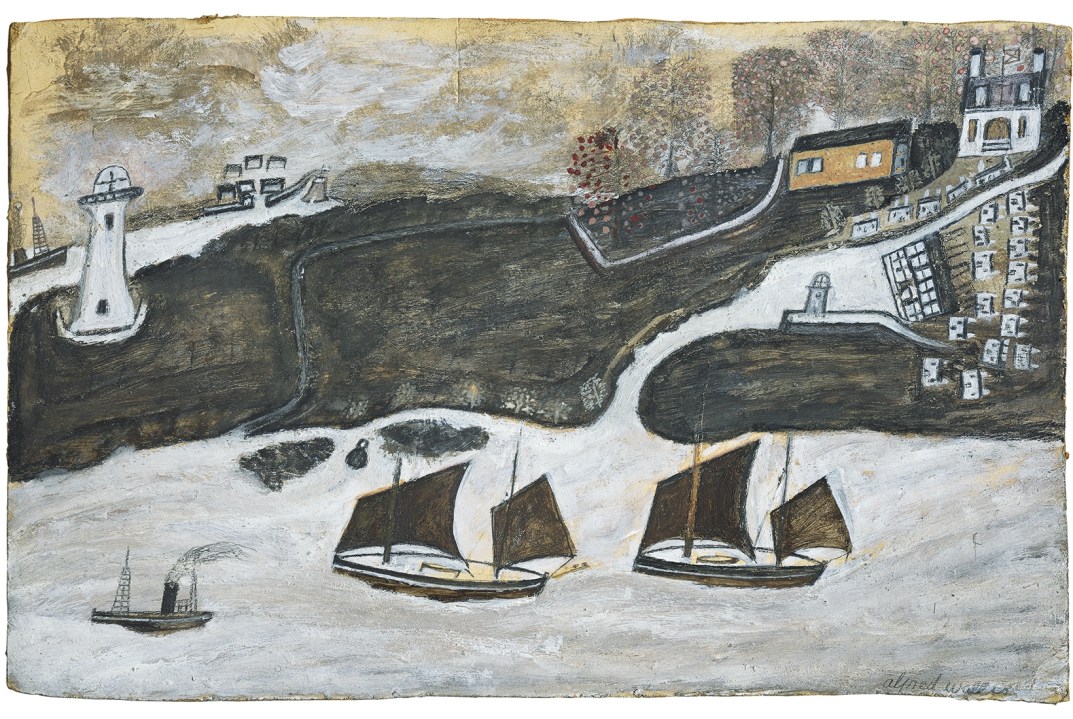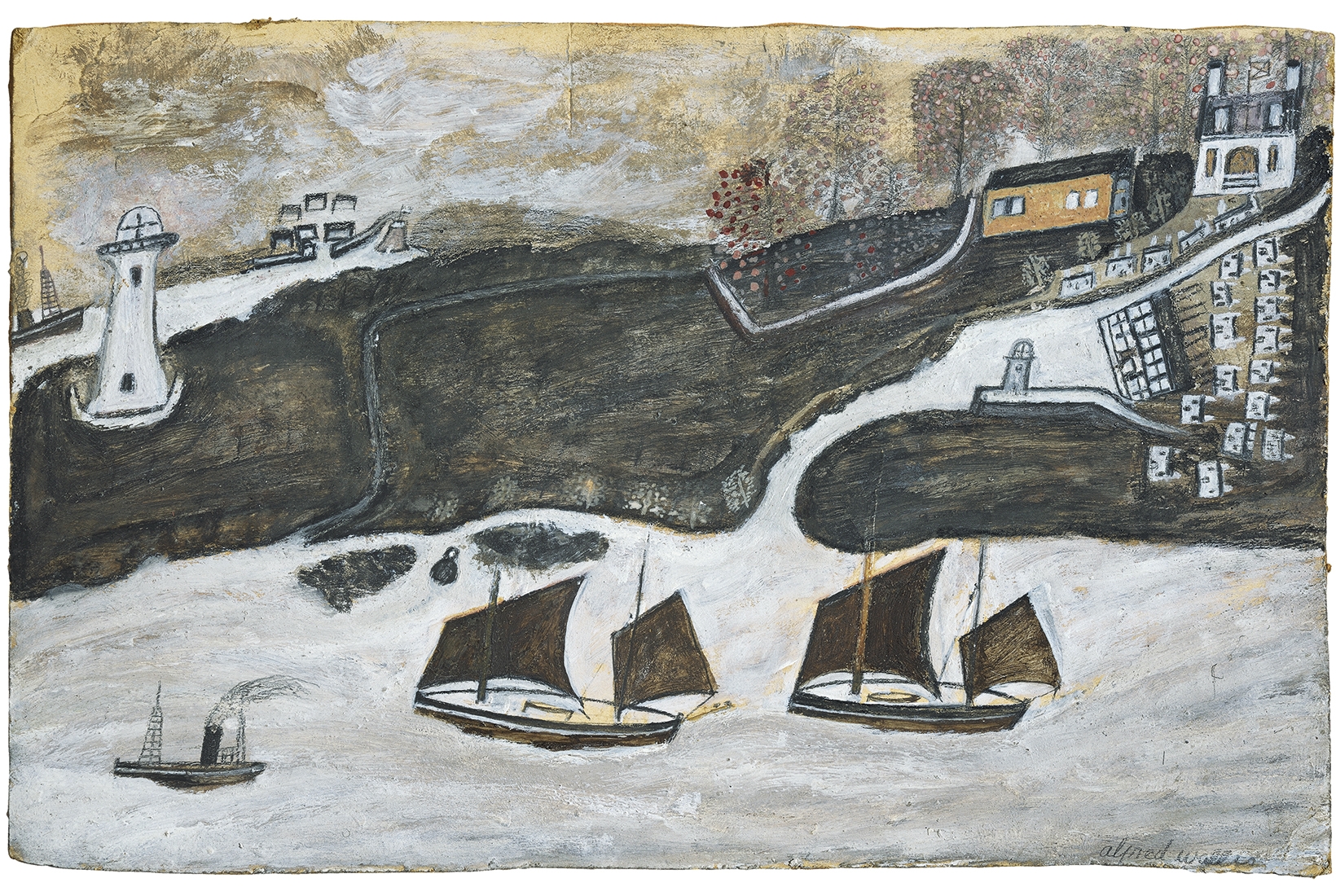Alfred Wallis (1855-1942) should be an inspiration to all late starters. It was not until he had passed the age of 70 that, after his wife of many years had died and having previously worked as a sailor, fisherman and rag and bone merchant, he decided to take up art. ‘Aw! I dono how to pass away time,’ he explained to a shopkeeper in his native town of St Ives. ‘I think I’ll do a bit a paintin’ — think I’ll draw a bit.’
Three years later, his work was spotted by the leading British modernists Ben Nicholson and Christopher Wood. By and by, Wallis’s pictures were being exhibited in London, and Nicholson presented one to the Museum of Modern Art, New York.How much this acclaim meant to the artist, beyond bringing in some useful cash, is not clear. Once, shown a reproduction of one of his own works in a book, he was unimpressed, remarking: ‘I’ve got one like that at home.’
A new exhibition at Kettle’s Yard, Cambridge, Alfred Wallis Rediscovered, is devoted to this remarkable painter. As you go around it you can see what Nicholson and Wood must have seen on the day in August 1928 when they glanced through an open door on a backstreet in St Ives, and discovered Wallis and his work.
‘I do not put collers what Do not Belong i Think i spoils the pictures’
Nicholson later wrote that he associated the old seaman with ‘lovely dark browns, shiny blacks, fierce greys, strange whites and a particularly pungent Cornish green’. And all those dense colours are on show at Kettle’s Yard, applied to odd-shaped bits of paper and cardboard cut from the sides and bottoms of boxes. What you see is not the blue sea and sunshine of tourist posters, but what Wilhelmina Barns-Graham — a St Ives painter of a later era — once told me were the true hues of the place: ‘grey seas, black rocks.’
It was not surprising Wallis had an intense feeling for ships, having spent his life on and around boats. He wrote as much to Jim Ede, founder of Kettle’s Yard and loyal collector of his works: ‘What I do mosley is what use To Bee out of my memory what we might never see again.’ Some of his letters are on display in the exhibition, revealing, in addition to his idiosyncratic spelling and punctuation, that Wallis had beautiful handwriting, making these letters as calligraphically handsome as those from his slightly older contemporary, Vincent van Gogh.
This in turn suggests a vital clue to his art: despite (or because of) being barely educated and highly eccentric, Wallis had a strong innate visual sense. That was why ‘doing a bit of painting’ came into his mind when he found himself a widower. He started too with what many painters, trained or untrained, never get: a disciplined, individual chromatic sense.
Among the first things he said to Nicholson was: ‘You don’t want to use too many colours.’ Later he expanded on this theme to Ede: ‘I do not put collers what Do not Belong i Think i spoils the pictures Their have Been a lot of paintins spoiled By putin collers where they do not Blong.’
Nicholson also quickly saw, perhaps in that first glimpse through the door, that Wallis had a radical sense of composition. His bits of cardboard were seldom conventional squares and rectangles. Their corners were rounded or sheared off, their tops were domed, their sides chewed-looking and ragged.
Wallis arranged his forms to rhyme with these shapes so that, for example, the coastlines in ‘Penzance Harbour’ follow the irregular edges of the bit of cardboard box as if on a map; the massive supporting pier of ‘Saltash Bridge’ (c. 1935-37) sticks up into the wonky triangle of the picture-space while tiny boats bob about at its foot.
Wallis escaped the prison of artistic conventions by the simple expedient of not knowing about them. But there was more to him than that. He was what is known as an ‘outsider artist’, but he was an outsider among outsiders because his talent was so strong (though only when he painted the sea and ships, as is clear from this exhibition).
He not only influenced Nicholson and Wood, his pictures make theirs — hung side by side for comparison — look a bit weak. His pictures of giant fish, both beneath the water and apparently lying on the surface, bring Paul Klee to mind. And I suspect that if Kettle’s Yard had added a Klee to the mix, Wallis would still hold its own.
Why was this ‘very fierce and lonely little man’ so good at painting? That’s the mystery. More was going on in his mind than we’ll ever know. Nicholson once asked him what a huge fish in a certain picture was. Wallis’s face lit up. ‘That?’ he replied. ‘That’s a land-shark!’ And he went on smiling for a long time afterwards.







Comments